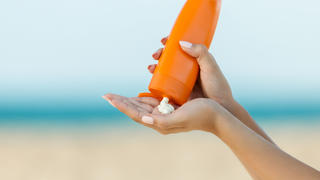Heading Down the Shore? Saint Joseph’s PharmD Candidates Explain Why You Should Think Twice When Selecting Sunscreen
Colleen Huzinec, PharmD ’25, and Luz Rosario, PharmD ’25, discuss key factors consumers should consider when choosing sunscreen.

Before going on a summer vacation to the shore, you probably have some beach essentials in mind. You will likely want to bring a cooler filled with refreshing drinks, beach towels to lay on top of the hot sand and a book to read while listening to the crashing waves. However, the most important item to prevent days of discomfort and peeling is sunscreen.
Heading to the local pharmacy to pick up sunscreen is a relatively mindless activity. Instead of only looking at the product’s sun protection factor (SPF), Colleen Huzinec, PharmD ’25, and Luz Rosario, PharmD ’25, students in Saint Joseph’s University’s Doctor of Pharmacy program, explain why consumers should pay closer attention to what ingredients they are lathering on their skin.
Q: What is your overall advice for choosing which sunscreen to purchase?
Huzinec: Look for broad spectrum sunscreen. That will cover the ultraviolet A (UVA) and ultraviolet B (UVB) rays. Also, choose a sunscreen with a SPF of 30 or higher for daily use all over the body. This is especially important if you are going outside. You want to make sure every aspect of your body is covered from head to toe, including the scalp. Reapply the sunscreen every two hours and use a water-resistant kind if you plan on getting wet. Lastly, while spray-on sunscreen is easier, use the cream. The cream allows you to get all parts of your body and prevents missing certain areas like the ears, behind the arms, etc.
Rosario: Another factor to consider is your age. For children who are six months of age or younger, it is not recommended to use sunscreen. Instead, other approaches include keeping them in the shade as much as possible, as well as dressing them in light colors, lightweight clothing, long sleeves and a wide-brimmed hat when outside this summer.
Q: In 2021, the Food and Drug Administration reported that only two active ingredients, zinc oxide and titanium dioxide, are “generally recognized as safe and effective.” While these ingredients are often not found in chemical-based sunscreen, they can be found in mineral-based sunscreen. Would you recommend mineral-based sunscreen or chemical-based sunscreen?
Huzinec: I would recommend mineral over chemical. The best way to help our patients is by going into the aisle with them and showing them exactly what to look for. Patients are often focused on the name brand or SPF, but they don’t look at the fine print to see what ingredients are inside of them.
Rosario: I would also recommend mineral over chemical. It’s important to know mineral sunscreen will most likely leave a white cast when applying it to your skin. It is not ideal for a lot of patients, but the benefits outweigh the risks in terms of using this type of sunscreen.
Huzinec: There are also tinted and lightweight mineral sunscreens. So, that is one way to overcome the white cast, especially for patients with darker skin tones.
Q: What is the difference between mineral-based sunscreen and chemical-based sunscreen?
Huzinec: Mineral sunscreens, also known as physical sunscreens, sit on top of the skin and reflect sunlight. Meanwhile, chemical sunscreens are absorbed by the skin. It is the opposite of what you may think in terms of effectiveness. Reflecting sunlight is more effective than getting absorbed into the skin. So, look for products with zinc oxide or titanium dioxide.

Q: Why do you think this isn’t common knowledge?
Rosario: Education is part of it. Growing up, I never thought I would need to wear sunscreen every day because it wasn't something I was taught to do. Whereas now, I use a moisturizer that also has sunscreen in it, after being exposed to this information through school and my own research. Also, I have educated my family members on it. It is within a pharmacist's scope to educate our community about many topics including sunscreen use, as we are one of the most accessible healthcare professionals in our community.
Huzinec: I think people don’t pay attention to it. They are so focused on SPF and go with a name brand that they think is best for them and their skin type. Many people do not think of asking a pharmacist as it is not a medication to them. They may think we don’t know much about sunscreen, but we do!
Q: Are there any other recommendations you have for patients regarding sunscreen?
Huzinec: Some medications can make you more sensitive to the sun. For example, antibiotics in the tetracycline or quinolones drug class. The pharmacist’s responsibility is to counsel patients on the importance of wearing sunscreen, long sleeves, pants, hats, etc when taking these medications and going outside in the sun.
Rosario: You should always keep expiration dates in mind. The FDA monitors ingredients in sunscreen as it is an over-the-counter product. If no expiration date is listed, it is important to note that sunscreen retains its original strength and works for three years. If it has been longer than three years, it is time to throw it out and use a new one!
To learn more about Saint Joseph’s Philadelphia College of Pharmacy, visit https://www.sju.edu/departments/philadelphia-college-pharmacy.



